2022-2023 年福建福州高一英语上学期期末试卷及答案
B. A rabbit.
C. A toy
C. The man’s pet.
B. At about 3:50.
C. At about 4:50.
B. At an Italian restaurant.
C. At a Chinese restaurant.
第一部分 听力(共两节,满分 30 分)
做题时,先将答案标在试卷上。录音内容结束后,你将有两分钟的时间将试卷上的答案转
涂到答题卡上。
第一节(共 5 小题;每小题 1.5 分,满分 7.5 分)
听下面 5 段对话。每段对话后有一个小题,从题中所给的 A、B、C 三个选项中选出最佳选
项。听完每段对话后,你都有 10 秒钟的时间来回答有关小题和阅读下一小题。每段对话仅
读一遍。
1. Where did the speakers have dinner last night?
A. At home.
2. Why won’t the man go to the party in fact?
A. He is a little tired.
B. He thinks the party is too noisy.
C. He has to stay with his daughter.
3. What present has the woman bought for the baby?
A. Clothes.
4. What are the speakers mainly discussing?
A. Their friend. B. A dog owner.
5. When will the woman call back probably?
A. At about 3:00.
第二节(共 15 小题;每小题 1.5 分,满分 22.5 分)
听下面 5 段对话或独白。每段对话或独白后有几个小题,从题中所给的 A、B、C 三个选项
中选出最佳选项。听每段对话或独白前,你将有时间阅读各个小题,每小题 5 秒钟;听完后,
各小题将给出 5 秒钟的作答时间。每段对话或独白读两遍。
听第 6 段材料,回答第 6、7 题。
6. What is the man doing?
A. Repairing a phone.
7. What does the man care most about the phone?
A. The camera.
B. The battery.
听第 7 段材料,回答第 8 至 10 题。
8. What is on the corner of the Callahan Road?
A. A bank.
9. How long will the man drive on the Callahan Road today?
A. About 15 minutes.
10. Where is the art museum?
A. Beside a block.
听第 8 段材料,回答第 11 至 13 题。
11. What is the conversation mainly about?
A. A child.
12. What do we know about the teacher?
A. He has artistic skills.
B. He gives up the child.
C. He offers help to the child.
13. How does the boy feel in the end?
A. Sad.
听第 9 段材料,回答第 14 至 16 题。
14. What does Eric dislike?
A. Carrots.
B. Opposite a cinema. C. Behind a park.
B. About20minutes. C. About 30 minutes.
B. Choosing a phone.
C. Introducing a phone.
B. Milk products.
C. Strawberries.
B. Hopeful.
C. Surprised.
B. A film.
C. A teacher.
B. A school.
C. A theater.
C. The price.
�
B. Quiet.
C. Clean.
B. East Africa.
C. South America.
B. Husband and wife. C. Cook and customer.
15. What-is the relationship between the speakers?
A. Schoolmates.
16. Where do the man’s banana g come from?
A. Asia.
听第 10 段材料,回答第 17 至 20 题。
17. What does the speaker think of Bangkok?
A. Exciting.
18. What is a better way to visit Bangkok?
A. To get a taxi.
19. What does the speaker mention at last?
A. The accommodation.
B. The local food.
20. What does the speaker probably do?
A. A travel guide.
第二部分 阅读(共两节,满分 40 分)
第一节(共 15 小题;每小题 2 分,满分 30 分)
阅读下列短文,从每题所给的 A、B、C、D 四个选项中选出最佳选项。
B. A hotel manager.
C. A cook.
B. To take a bus.
C. To catch an express boat.
C. The places of interest.
A
Mary-Jo Saunders goes to kindergarten every morning, just like many other
five-year-olds in New York. Today, she is learning a poem. What is special is that
it’s a Chinese poem and that she is able to recite it without an accent. Soon she
is going to learn Chinese handwriting too. “Learning the world’s most spoken
language might give Mary-Jo a head start in her future jobs” says her mother Alison.
“I think it’s good for her to stretch herself (端尽所能) by listening to and
pronouncing new sounds, as well as learning to read and. write Chinese characters.”
More and more parents in the world are sending their children to Chinese classes.
Keen for their sons and daughters to succeed in lift, they see being fluent in a
second or third language as an advantage. Learning Chinese is becoming so popular
that the language has been included in the education systems of more than 75 countries.
Over 4,000 overseas universities offer Chinese language courses and about 25 million
people are learning Chinese outside China.
It is easy to understand why Chinese is becoming so popular. Learning Chinese
may help people get more chances to work. China is already a global economic power,
and its influence is growing. For example, there’s China’s Belt and Road Initiative
(倡议), which encourages many countries along the Silk Road to work together more
closely. It has created thousands of local jobs, many of which need people with a
knowledge of Chinese. Another reason is that studying Chinese provides chances to
explore wonderful Chinese history and culture. Adam Turner, a school head teacher
in the UK, mentions this as one of the most attractive parts of the recently added
Chinese course. “Students love the mystery (奥秘) of China,” he explains. “They
want to know all about its traditions, dynasties and art forms. Learning Chinese
helps them see life differently and increase their knowledge of the outside world.”
1. Why did the writer mention Mary-Jo Saunders’ story in paragraph 1?
A. To praise Mary-Jo Saunders’ hard work in learning Chinese.
B. To introduce a funny way of learning Chinese in New York.
C. To stress the great difficulty of learning Chinese for foreigners.
D. To show the growing interest in learning Chinese outside China.
2. Which of the following best explains the underlined phrase “keen for” in
paragraph 2?
A. Telling.
C. Requesting.
3. How does the writer show people’s attitude towards learning Chinese outside China?
B. Expecting.
D. Advising.
�
B. By finding excuses.
D. By offering suggestions.
A. By listing numbers.
C. By making comparisons.
4. What advantage can learning Chinese bring?
A. Traveling all over the world and having fun.
B. Doing business globally and making more money.
C. Getting a job and a deeper understanding of China.
D. Improving relationships with other countries.
5. What is the best title for this text?
A. Chinese Learning: Increasing Popularity.
B. Chinese Language: A Head Start in School.
C. Chinese Handwriting: Traditions and Art Forms.
D. Chinese Characters: Reading and Writing for Fun.
【答案】1. D
4. C
2. B
3. A
5. A
B
In a working site near Paris, several people are busy cleaning a canvas (画
布), trying to correct the pains of time: the repairing of 22 paintings of Notre-Dame
(巴黎圣母院) which was damaged by a fire in April 2019, is “a race against time”.
The project of repairing these works, which must be returned to the building
for its reopening in 2024, is a unique one compared to others.
“Two years may seem like a long time, but that’s the time it takes to do the
job of simply one canvas like The Triumph of Job, which is behind us,” one expert
Laurence said, pointing out the huge work several meters high by the Italian artist
Guido Reni, which was hung behind her back.
“You do not touch a canvas without knowing its medical history”, underlines
Lavit, heritage curator (馆长) at the Center of research and repair of the Museums
of France.
Once this history is known, the paintings move on to cleaning. The
protector-repairer Pasquali stresses that it is a team effort.
Opposite her is Hulot, an expert in repair. One object of his attention is The
Martyrdom of Saint Bartholomew by French artist Lubin Baugin. His job is to make
sure that the canvases do not break.
Meanwhile, another team takes care of the frames. “The heat of the fire dried
and weaken the wood,” comments Galopin.
Once all these steps have been completed, the paintings are stored in a special
room. It takes between 8 and 10 people to move them safely. They will remain there
until the reopening of the church.
6. What do we know about the repair work?
A. Its focus is on cleaning a canvas.
B. It is considered as the pains of time.
C. It is different from all other projects.
D. Its working site is in the city of Paris.
7. Why does the writer say the repair work is “a race against time”?
A. The paintings were badly damaged in the 2019 fire.
B. Workers need to spend two years studying one canvas.
C. The huge work of an Italian artist should be returned soon.
D. The project is to be completed by the reopening of the church.
8. How many paintings are mentioned in the text?
A. One.
9. Which one of the following is the last step of the project?
A. Moving on to cleaning.
C. Three.
D. Four.
B. Two.
�
B. Taking care of the frames.
C. Storing the paintings in a room.
D. Getting to know its medical history.
10. Which section of a newspaper is the text most probably taken from?
A. Travel and Experience.
C. Science and Technology.
【答案】6. C
B. Art and Culture.
D. History and Legend.
9. C
7. D
8. B
10. B
C
Researchers from Aarhus University and University of Gothenburg have produced
new maps of mammals (哺乳动物) to date connecting all living and recently extinct
mammal kinds-nearly 6,000 in total.
Earlier similar studies always left out one key group of mammals: species driven
to extinction by humans.
Scientists often use these maps to predict how climate change will affect species.
And because the new ones show species’ footprints, they help scientists b otter
see many species have had their numbers greatly reduced by humans for example,
through over hunting and the destroying of their habitats.
“Brown bears may lead us to think of Alaska or Russia today but they used to
cover all the way from Mexico to Northern Africa before they were widely hunted by
humans.” said Faurby.
We usually think large mammals like elephants and lions line in Africa today,
but for most of the last 30 million years, big animals traveled all over the Earth.
It was only recently that humans drove many of these large mammals extinct, leaving
a world depauperate of large mammals.
“Even some huge species that we think of as prehistoric, lived up to the time
the Great Pyramid was being built,” Davis said.
Making a database that included every species of mammal was no easy task. It
took the research team at Aarhus University months just to piece together existing
datasets and fill in missing holes in the data.
Marking footprints on the map for them was even harder. The scientists used both
DNA information and data from some dig sites around the world with a powerful new
computer algorithm (算法) to predict where the extinct species fit in with mammals
that are alive today.
11. What is special about the new maps of mammals?
A. They are marked with dates on them.
B. They map one key group of mammals.
C. They are not so complete as earlier ones.
D. They include 6000 extinct mammal kinds.
12. What’s the writer’s attitude towards the maps?
A. Positive.
Doubtful.
13. What do we know about large animals?
A. Elephants and lions are all over the world now.
B. They died out long before the Pyramids were built.
C. Brown bears were once limited to Alaska or Russia.
D. They have been greatly affected by human activities.
14. What does the underlined phrase “depauperate of” mean in paragraph 5?
A. Short of.
Suitable for.
15. What’s the main idea of the last two paragraphs?
C. Famous for.
B. Concerned.
B. Full of.
C. Unclear.
D.
D.
�
A. The computer algorithm is of great use.
B. It took ages to find DNA evidence.
C. Missing holes are pieced together.
D. It took a lot to complete the task.
【答案】11. B
第二节(共 5 小题;每小题 2 分,满分 10 分)
阅读下面短文,从短文后的选项中选出可以填入空白处的最佳选项。选项中有两项为多余
选项。
14. A
15. D
12. A
13. D
It’s strange, but I don’t really remember much about the hurricane itself.
____16____ I was sitting in my room with my cat, Smartie, on my lap, when the roof
just flew off. All of a sudden, there was sky where the roof had been. I was so
frightened that I just froze(保住不动).
Mom cried to get out quickly, but it was already too late by then. The rain was
coming down so hard and so fast. ____17____ We were going nowhere.
At first, I was pleased we could stay at home, but soon it got really difficult.
____18____ There was water everywhere, but we couldn’t drink any of it or else we’
d get really sick. We just had drinking water that was sent to us by helicopter,
but it was never enough. It was August, so it was really, really hot and it smelled
so bad everywhere! I just spent the days watching the boats going up and down the
street and looking out for Smartie. ____19____
Living in the open air, we became breakfast, lunch and dinner for the
mosquitos(蚊子). But Mom said that whatever happens, we should always try to see
the good side of things. ____20____ We had lost our home and everything in it. All
we had left were the clothes on our backs. But thankfully, Smartie came home just
in time. As Mom kept on reminding(提醒) us, we were all together and safe. Mom’
s words made us feel better and gave us hope for the future.
A. It all happened so quickly.
B. We were so happy to take him with us.
C. It was difficult to stay positive, though.
D. Our street turned into a river in seconds.
E. He had disappeared the moment the storm hit.
F. Now, one year has passed and I’m back home.
G. Without a roof, staying inside was too dangerous.
【答案】16. A
第三部分 语言运用(共两节,满分 30 分)
第一节(共 15 小题;每小题 1 分,满分 15 分)
阅读下面短文,从每题所给的 A、B、C、D 四个选项中选出可以填入空白处的最佳选项。
19. E
20. C
17. D
18. G
It’s a beautiful day in Jaen capital of Jaen Province of Southern Spain. The
September ____21____ beats down on a sea of wedding(婚礼)guests. As Dave makes a
final toast( 祝 酒 词 ), the guests ____22____ applause( 掌 声 ), because he just
____23____ his speech in Spanish, which he couldn’t speak a year ago.
Dave and his wife Carol were in South Wales when their son Stewart called from
Spain and asked them to meet a(n) ____24____ lady-Atanea and her family. ____25____,
Dave and Carol traveled to Spain to meet them, where they felt very ____26____,
because they couldn’t speak Spanish. It was Atanea who acted as ____27____ to make
everyone understood. One week later Stewart asked Atanea to ____28____ him, and she
said yes. Dave wanted to ____29____ his son and connect with his in laws on a deeper
level, so the mom and he arrived in the UK, Dave ____30____ Spanish lessons in the
local learning center.
Dave’s months of hard work and ____31____ come together in one wonderful
expression of ____32____ for Stewart and Atanea. No wonder he receives warm applause.
�
D. sun
D. watch
D. strong
D.
D. trust
D.
B. expert
C. translator
B. recorded
C. revised
B. confident
C. awkward
C. tail
C. receive
C. aged
C. Relaxed
B. special
B. Confused
B. weather
B. break into
____33____ Atanea’s family are applauding more than Dave’s speech. They are
applauding the respect Dave shows for their ____34____. Through learning Spanish,
Dave shows his new in-laws that he wants to be part of their lives and that he
____35____ his daughter-in-law deeply. After all, she couldn’t translate for them
forever.
21. A. morning
22. A. draw
over
23. A. delivered
protested
24. A. busy
25. A. Annoyed
Excited
26. A. comfortable
regretful
27. A. volunteer
professor
28. A. marry
29. A. calm
support
30. A. looked forward to
over
31. A. courage
determination
32. A. love
33. A. So
34. A. guests
wedding
35. A. moves
worries about
【答案】21. D
D
第二节(共 10 小题;每小题 1.5 分,满分 15 分)
阅读下面短文,在空白处填入 1 个适当的单词或括号内单词的正确形式。
C. credit
C. But
C. culture
B. respect
B. Then
B. in-laws
D. demand
D. Or
D.
D. picked up
B. experience
30. B
31. D
32. A
33. C
C. help
C. contact
C. responsibility
D.
B. signed up for
C. went
25. D
34. C
26. C
35. B
B. cares about
C. impresses
22. B
23. A
24. B
D.
D.
D.
D.
B. accept
B. praise
27. C
28. A
29.
Chicken-blood stone ____36____(be) one of China’s most valuable materials and
has been used for centuries to create carved works with red markings. With its bright
blood-red color, bright crystal-like jade (玉) texture quality and shape,
chicken-blood stones are celebrated around ____37____ world. The artistic value of
Changhua chicken-blood stone lies in its adaptability, which can ____38____ (process)
into decorations (装饰品) of different sizes and forms.
____39____ (recent) Crafts man Qian Gaochao and his son spent more than six
months ____40____ (make) three “chicken-blood” stone carvings showing the
competitions of the 19th Asian Games HangZhou 2022, such as taekwondo and wrestling.
As a ____41____ (nation) inheritor (继承人) of the intangible (非物质) cultural
heritage of the chicken-blood stone carving skills, Qian Gaochao says, “I’m not
only doing carving work but also recording the ____42____ (develop) and changes of
our society and remembering the era through my carvings. Besides, we often hold
research activities and provide training courses ____43____ that more young students
can understand and learn Chinese traditional culture.” So far, he has created many
fine works, most of ____44____ are related to important events in Chinese history
and famous people who have made great contributions _____45_____the country.
�
37. the
41. national
【答案】36. is
38. be processed
39. Recently
40. making
42. development
43. so
45. to
第四部分 课内知识(共三节,满分 25 分)
第一节(共 7 小题;每小题 1 分,满分 7 分)
根据语境,选择下框中的单词替换句中划线部分的词或词块,使之意思一致。
44. which
A. investigate
F. preserve
B. appreciate
C. related
D. struggle
E. struck
G. effect
46. This aid programme will have a great influence on girls’ education in Africa.
47. Old Korean and Japanese characters are connected to Chinese characters.
48. When I started studying German, it was a difficult thing for me to do.
49. A huge earthquake hit Wenchuan, China at 2:28 p.m, on 12 May 2008.
50. The scientist suggested establishing a committee of experts to protect the
cultural heritage.
51. The situation was becoming so serious that the officials were asked to try to
find out the truth about the issue immediately.
52. An increasing number of international students are beginning to recognize the
good qualities of China’s culture and history.
【答案】46. G
48. D
50. F
52. B
第二节(共 8 小题;每小题 1 分,满分 8 分)
根据语境,选择下框中的单词或短语,必要时用正确的形式填空。框中有两个多余的单词或
短语。
49. E
51. A
47. C
promote
in shock
supply
carve
keep a balance
proposal
shelter
means
point of view
donate
53. An emergency ______ of food was transported to the area by the army.
54. Chinese writing was first done by ______ symbols onto bones and shells.
55. Everyone was ______ to see that a large city lay in ruins after the earthquake.
56. ______ between work and family can be a big challenge for many parents.
57. Reading books about ancient civilisations gave me a new ______ on my own world.
58. Experts conducted several tests and then made a ______ for how the buildings
coud be saved.
59. Many countries took part in the project and ______ money to protect cultural
sites along the Nile River.
60. Because the houses are round, they can survive strong winds and floods, and are
good ______ during a disaster.
【答案】53. supply
54. carving
55. in shock
56. Keeping a balance
57. point of view
�
58. proposal
59. donated
60. shelters
第三节(共 5 小题;每小题 2 分,满分 10 分)
英汉互译。81~82 题按括号中的要求进行汉译英,83~85 题英译汉。
61. 人们学习一门外语的原因有很多。(使用定语从句)(汉译英)
【答案】There are a lot of/lots of/many reasons why people learn a foreign language.
62. 政府向已经研究过该问题的科学家寻求了帮助。(使用定语从句)(汉译英)
【答案】The government turned to the scientists who/that (had) studied the problem
(for help).
63. The soldier will remember the rescue worker with whom he has worked during the
earthquake.(英译汉)
【答案】这位士兵将会记住与他在地震中一起工作的救援人员。
64. The high regard for the Chinese writing system can be seen in the development
of Chinese characters as an art form. (英译汉)
【答案】中国人对汉字书写体系的推崇/尊重,体现在汉字发展为一种艺术形式。
65. UNESCO(联合国教科文组织) runs a programme that prevents world cultural heritage
sites from disappcaring. (英译汉)
【答案】联合国教科文组织进行着一个项目,旨在防止世界文化遗产(地点)的消失。
第五部分 写作(满分 25 分)
66. 假定你是学校英语报的记者李华,上周学校组织学生去少年宫 (the Children’s Palace)
参加活动,让学生在虚拟现实 (VR) 环境中体验自然灾害。请你以 Our Experience Activity
为题写一篇报道,要点如下:
1. 活动目的、时间等;
2. 体验的内容及感悟。
注意:1. 写作词数应为 100 左右;
2. 请按如下格式在答题卡的相应位置作答。
Our Experience Activity
_______________________________________________________________________________
_______________________________________________________________________________
_______________________________________________________________________________
_______________________________________________________________________________
_______________________________________________________________________________
____________________________________________________________
【答案】One possible version:
Our Experience Activity
Our school organized us to take part in an activity in the Children’s Palace
from 2:00 p.m. to 5:30 p.m. on December 17th. It was aimed to help us learn more
about natural disasters.
During the activity, we learned some basic ways to deal with different natural
disasters. We also experienced natural disasters such as an earthquake, a flood,
a tornado, a tsunami and a volcanic eruption in VR, where we deeply felt the danger
of natural disasters. Compared to the knowledge we have gained in our class, what
we have learnt in the activity is practical and instructive.
听力答案:1-5 ACACC
16-20 CACBA
6-10 BAACB
11-15 BCBBA
�
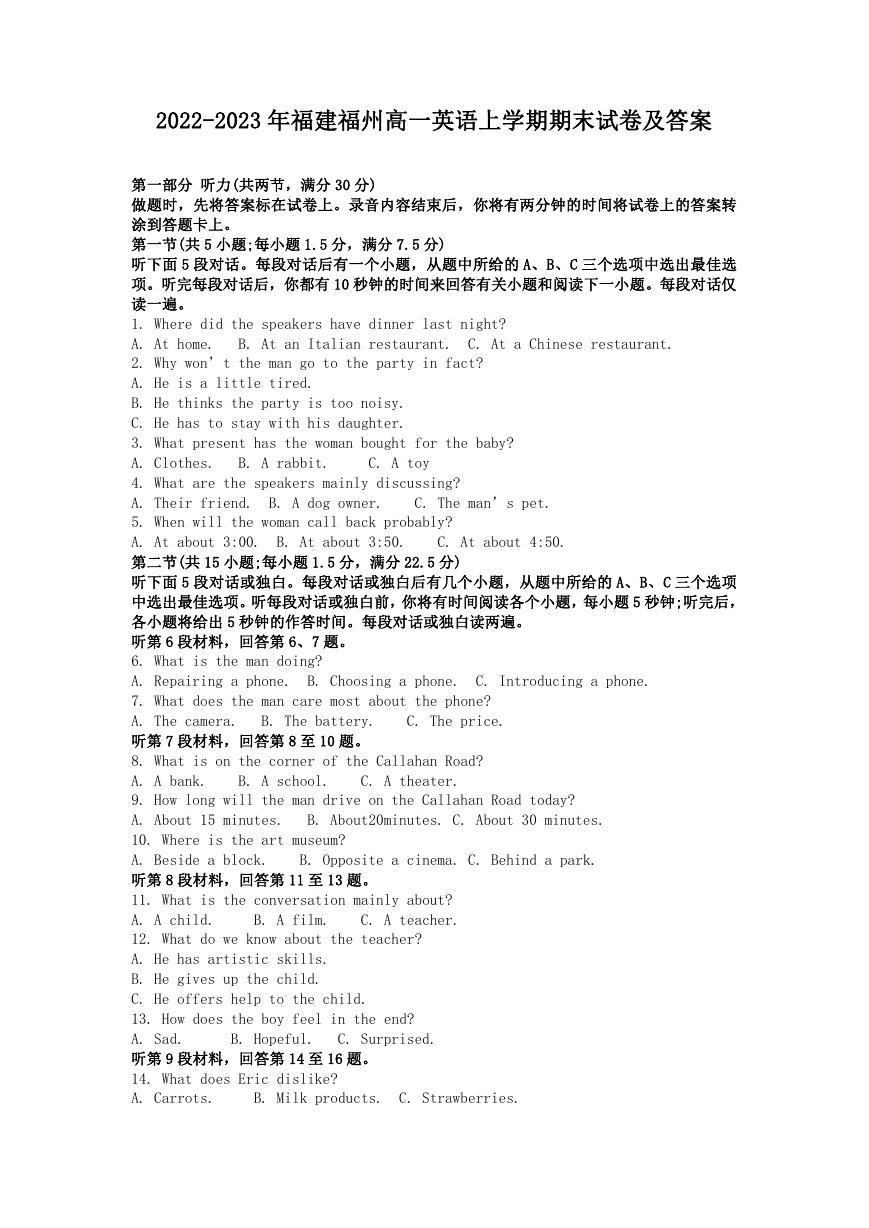
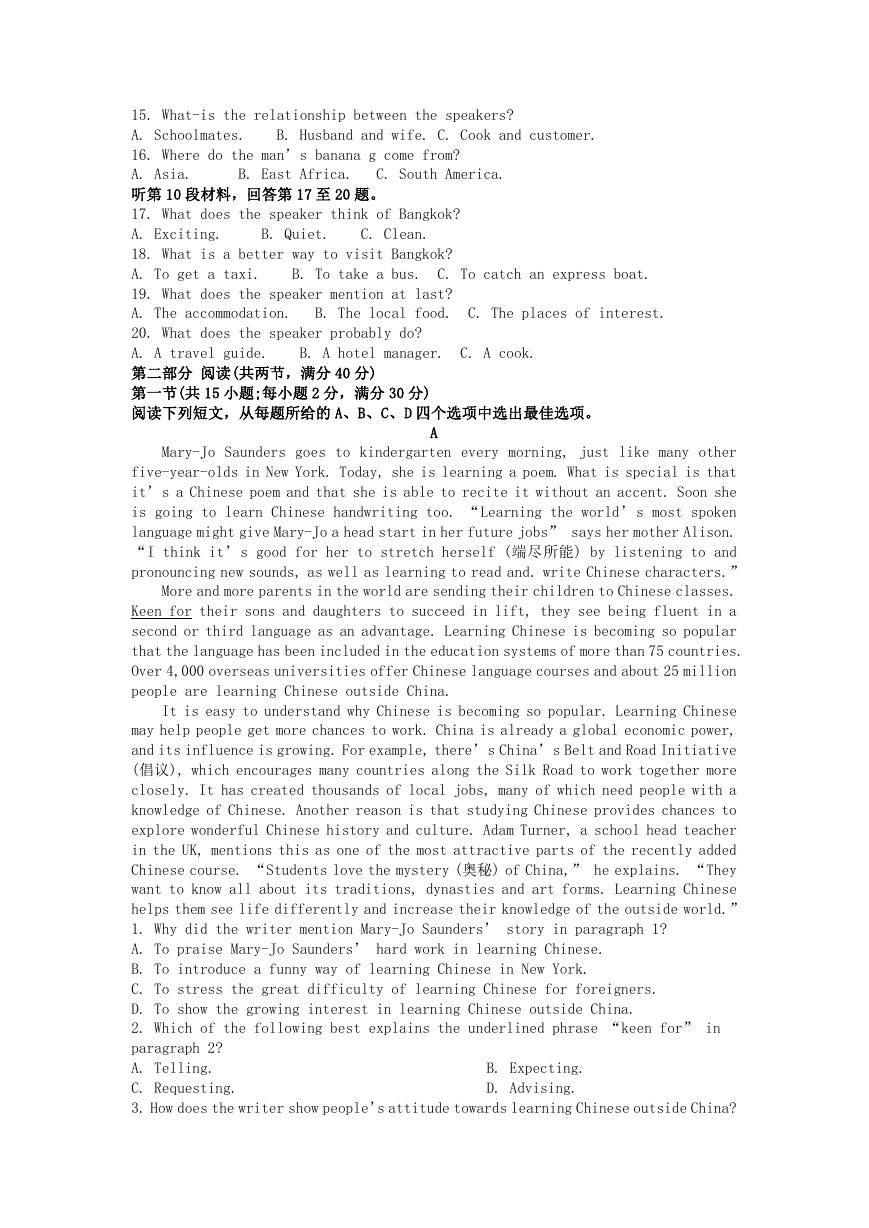
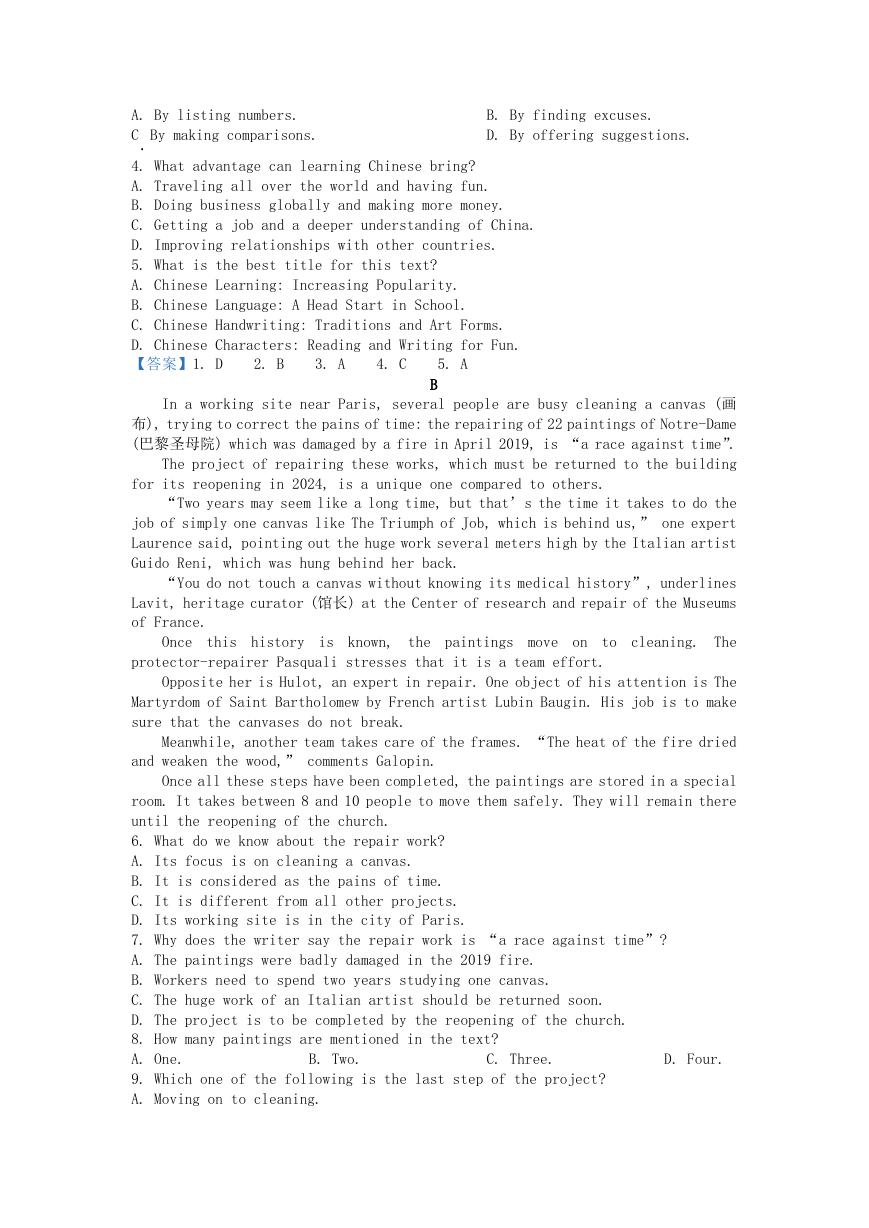
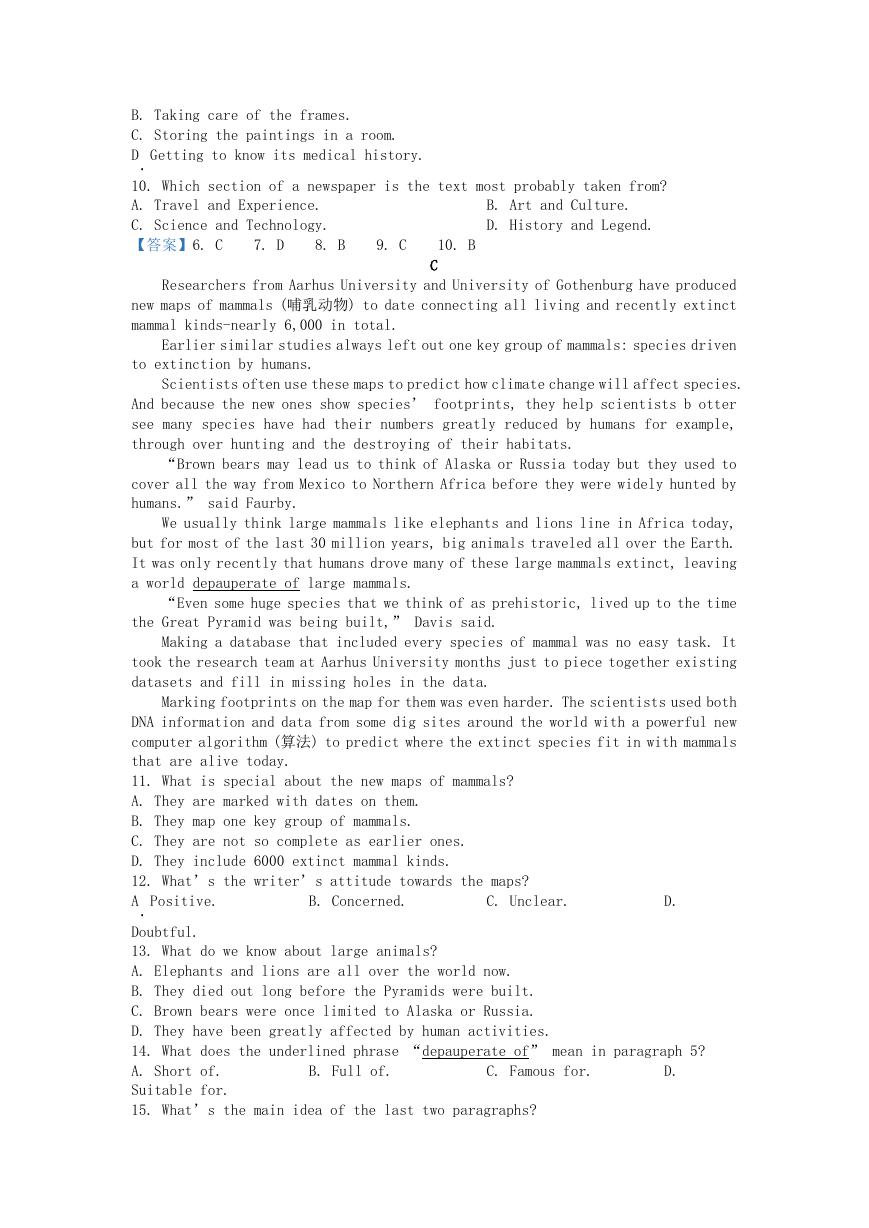

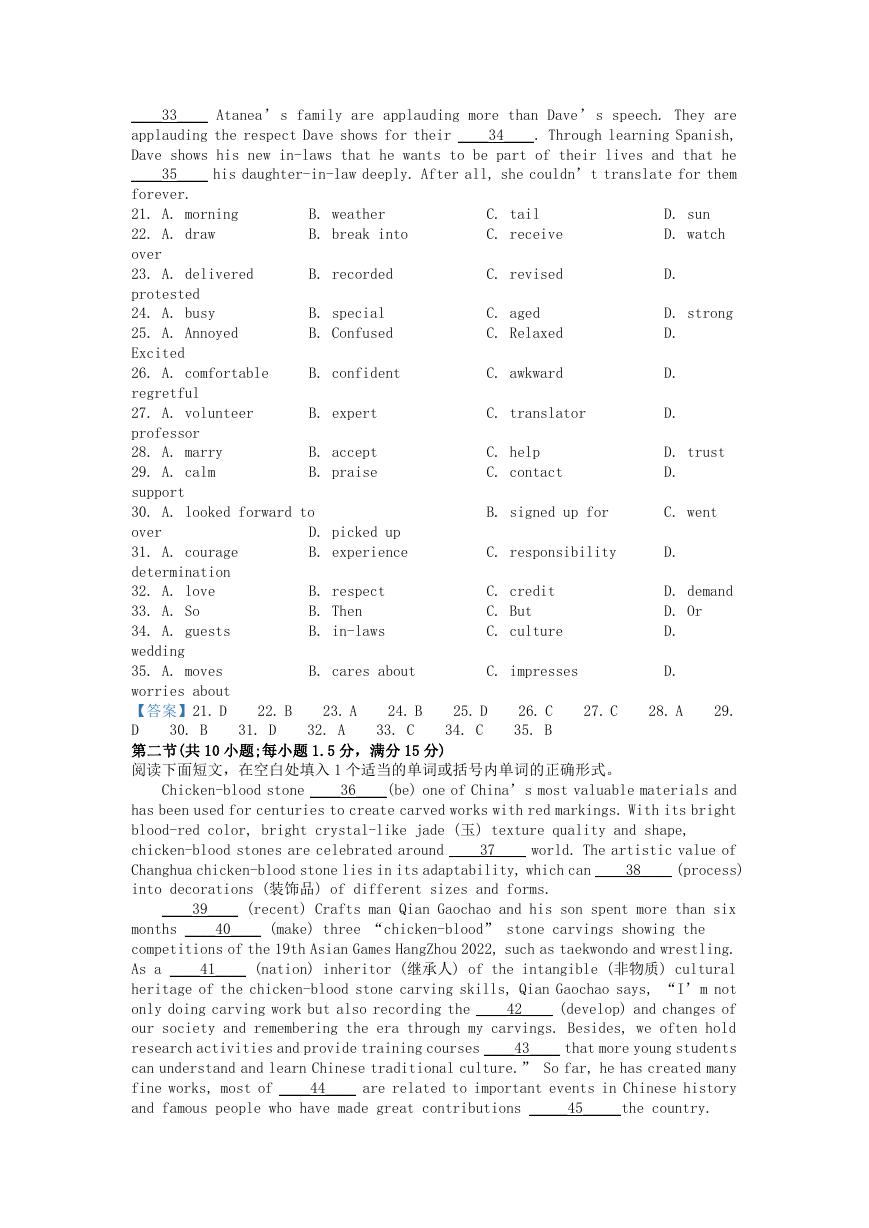

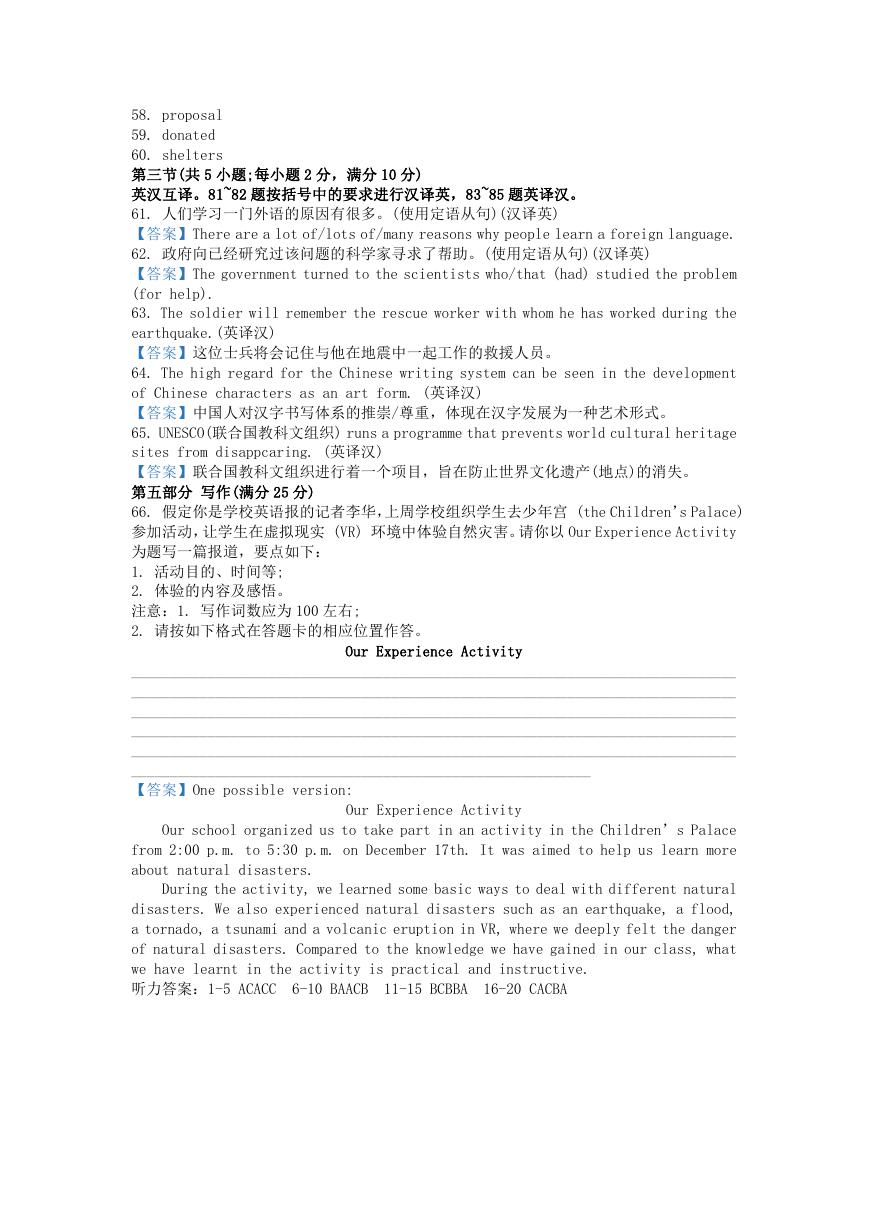








 2023年江西萍乡中考道德与法治真题及答案.doc
2023年江西萍乡中考道德与法治真题及答案.doc 2012年重庆南川中考生物真题及答案.doc
2012年重庆南川中考生物真题及答案.doc 2013年江西师范大学地理学综合及文艺理论基础考研真题.doc
2013年江西师范大学地理学综合及文艺理论基础考研真题.doc 2020年四川甘孜小升初语文真题及答案I卷.doc
2020年四川甘孜小升初语文真题及答案I卷.doc 2020年注册岩土工程师专业基础考试真题及答案.doc
2020年注册岩土工程师专业基础考试真题及答案.doc 2023-2024学年福建省厦门市九年级上学期数学月考试题及答案.doc
2023-2024学年福建省厦门市九年级上学期数学月考试题及答案.doc 2021-2022学年辽宁省沈阳市大东区九年级上学期语文期末试题及答案.doc
2021-2022学年辽宁省沈阳市大东区九年级上学期语文期末试题及答案.doc 2022-2023学年北京东城区初三第一学期物理期末试卷及答案.doc
2022-2023学年北京东城区初三第一学期物理期末试卷及答案.doc 2018上半年江西教师资格初中地理学科知识与教学能力真题及答案.doc
2018上半年江西教师资格初中地理学科知识与教学能力真题及答案.doc 2012年河北国家公务员申论考试真题及答案-省级.doc
2012年河北国家公务员申论考试真题及答案-省级.doc 2020-2021学年江苏省扬州市江都区邵樊片九年级上学期数学第一次质量检测试题及答案.doc
2020-2021学年江苏省扬州市江都区邵樊片九年级上学期数学第一次质量检测试题及答案.doc 2022下半年黑龙江教师资格证中学综合素质真题及答案.doc
2022下半年黑龙江教师资格证中学综合素质真题及答案.doc